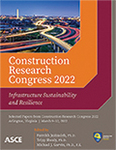Designing a Communication Practice to Build Community Capacity for Safer Housing
Publication: Construction Research Congress 2022
ABSTRACT
Communities in hazard-prone regions worldwide are navigating adverse impacts from increasing disasters, leaving many in a constant state of recovery and preparedness. In particular, in regions with weak regulatory enforcement of construction, such as Puerto Rico, housing is often built informally, that is, builders without formal training construct housing that may not adhere to formal building codes or other regulations. The safety of this informally constructed housing directly influences disaster impacts and a community’s recovery. In this study, we administer and analyze surveys on perceptions of safe building in Puerto Rico’s informal construction sector and compare this to engineering performance assessments of typical shelter designs in earthquake and hurricane events—two hazards to which Puerto Rico is exposed—to reveal design or construction practices that may be misaligned. We describe one of these misalignments, the preference for infill over confined masonry construction in seismic regions. We then propose an initial framework for the creation of a communication design practice that targets perceptions that do not align with engineering assessments of housing safety, applying communication theory to intervene in housing construction practices and reduce disaster risk.
Get full access to this article
View all available purchase options and get full access to this chapter.
REFERENCES
Ahmed, I. (2011). “An overview of post‐disaster permanent housing reconstruction in developing countries.” International Journal of Disaster Resilience in the Built Environment, 2(2), 148–164.
Asharose, Saizen, I., and Sasi, P. K. C. (2015). “Awareness Workshop as an Effective Tool and Approach for Education in Disaster Risk Reduction: A Case Study from Tamil Nadu, India.” Sustainability, Multidisciplinary Digital Publishing Institute, 7(7), 8965–8984.
Ashcraft, K. L., Kuhn, T. R., and Cooren, F. (2009). “Constitutional Amendments: ‘Materializing’ Organizational Communication.” Academy of Management Annals, Academy of Management, 3(1), 1–64.
Axley, S. (1984). “Managerial and organizational communication in terms of the conduit metaphor.” Academy of Management Review, 9, 428–437.
Barker, K. (2004). “Diffusion of innovations: A world tour.” Journal of Communication, 9, 131–137.
Bartolini, I., and Schacher, T. (2017). Introducing Confined Masonry in a Fragile State: The Case of Haiti After the 2010 Earthquake. 12.
Brzev, S., and Meli, R. (2012). International Guideline for Seismic Design of Low-Rise Confined Masonry Buildings in Regions of High Seismic Risk. Lisboa.
Burtolos, C., Kijewski-Correa, T., and Talfanidis, A. (2020). “The Housing Market Value Chain: An Integrated Approach for Mitigating Risk in Informal Residential Construction in Haiti.” Sustainability, 12(19), 8006.
Craig, R. (1999). “Communication Theory as a Field.” Communication Theory, 9(2), 119–161.
Davies, S. R., and Horst, M. (2016). Science Communication. Palgrave Macmillan UK, London.
Deetz, S. (1992). Democracy in an Age of Corporate Colonization: Developments in Communication and the Politics of Everyday Life. SUNY Press, New York.
Dinan, T. (2017). “Projected Increases in Hurricane Damage in the United States: The Role of Climate Change and Coastal Development.” Ecological Economics, 138(C), 186–198.
Fishbein, M. (2000). “The role of theory in HIV prevention.” AIDS care, 12(3), 273–278.
Goldwyn, B., Javernick-Will, A., and Liel, A. (2021). “Dilemma of the Tropics: Changes to Housing Safety Perceptions, Preferences, and Priorities in Multihazard Environments.” Natural Hazards Review, American Society of Civil Engineers, 22(3), 04021012.
Harrison, T. R. (2014). “Enhancing Communication Interventions and Evaluations through Communication Design.” Journal of Applied Communication Research, Routledge, 42(2), 135–149.
Hinojosa, J., and Meléndez, E. (2018). The Housing Crisis in Puerto Rico and the Impact of Hurricane Maria. Centro, 24.
Koschmann, M. (2012). What is Organizational Communication?
Macey, S. M., and Brown, M. A. (1990). “Demonstrations as a Policy Instrument With Energy Technology Examples.” Knowledge, SAGE Publications, 11(3), 219–236.
Magill, K. P., and Rogers, E. M. (1981). “Federally Sponsored Demonstrations of Technological Innovations.” Knowledge, SAGE Publications, 3(1), 23–42.
Marshall, J. D., Lang, A. F., Baldridge, S. M., and Popp, D. R. (2011). “Recipe for Disaster: Construction Methods, Materials, and Building Performance in the January 2010 Haiti Earthquake.” Earthquake Spectra, 27(S1), S323–S343.
Miranda, E., Acosta, A., Aponte-Bermudez, L., Archbold, J., Du, A., Cortes-Delgado, M., Gunay, S., Hassan, W., Heresi, P., Lamela, A., Messina, A., Miranda, S., Navarro, J., Padgett, J., Poulos, A., Scagliotti, G., Tsai, A., Kijewski-Correa, T., Mosalam, K., and Roueche, D. (2020). StEER - 7 Jan. 2020 Puerto Rico Mw 6.4 Earthquake: Preliminary Virtual Reconnaissance Report (PVRR).
Mix, D., Kijewski-Correa, T., and Taflanidis, A. A. (2011). “Assessment of Residential Housing in Léogâne, Haiti, and Identification of Needs for Rebuilding after the January 2010 Earthquake.” Earthquake Spectra, 27(S1), S299–S322.
Mokros, H. B., and Aakhus, M. (2002). “From Information-Seeking Behavior to Meaning Engagement Practice: Implications for Communication Theory and Research.” Human Communication Research, 28(2), 298–312.
Nguyen, L. T., and Corotis, R. B. (2013). “Seismic Risk and Society Development Indicators: Examination of Three Countries.” Natural Hazards Review, 14(2).
Opdyke, A., Javernick-Will, A., and Koschmann, M. (2018). “Household construction knowledge acquisition in post-disaster shelter training.” International Journal of Disaster Risk Reduction, 28, 131–139.
Spee, A. P., and Jarzabkowski, P. (2011). “Strategic planning as communicative process.” Organization Studies, SAGE Publications Ltd, 32(9), 1217–1245.
Vaara, E., and Whittington, R. (2012). “Strategy-as-Practice: Taking Social Practices Seriously.”
Zerio, A., Opdyke, A., and Javernick-Will, A. (2016). “Characterizing post-disaster reconstruction training methods and learning styles.” 6, 142–154.
Information & Authors
Information
Published In
History
Published online: Mar 7, 2022
Authors
Metrics & Citations
Metrics
Citations
Download citation
If you have the appropriate software installed, you can download article citation data to the citation manager of your choice. Simply select your manager software from the list below and click Download.
